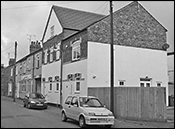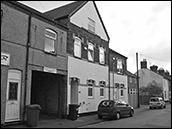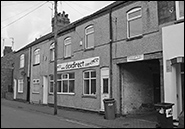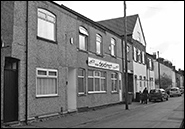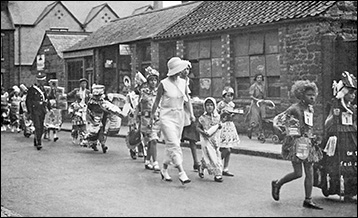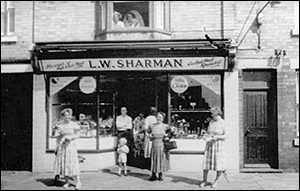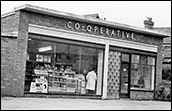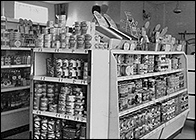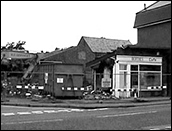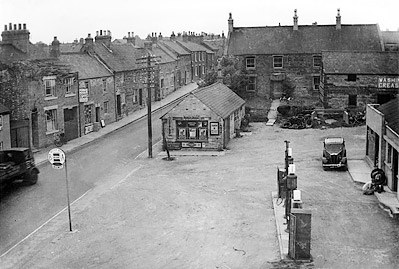|
|
Researched by John Langley 2006 with additions by John Meads in 2012 and 2013
|
|
|
Burton Latimer Shops - Section E
Duke Street & South High Street
|
|
|
|
|
|
|
3 Duke Street
(Shop 59) and
5 Duke Street
(Shop 60)
|
|
|
A parade passing 3 and 5 Duke Street, perhaps when
occupied by the Sturman family
|
The history of these shops has been combined as for considerable periods they have been occupied by the same owners. The 1911 census lists three shops from the street corner to the Weslyan Chapel: Cycle shop (Charlie Charles), Butchers shop (see below), Cycle shop (??).
The first possible occupier of one of them, most likely
3 Duke Street
, was Elias Smith who lived in
Meeting Lane
. A directory entry in 1898 gives him as a butcher in
Finedon Street
,
Duke Street
,
Rosebery Street
and
Corby
. Although this seems a lot of locations for one butcher, he may have owned the shops and employed other butchers since he was listed in several directories as a butcher and journeyman. There were certainly butchers shops in all these streets in the town at this time. The last recorded entry is in 1902. The first known owners, perhaps of number 3, from about this time were James and Fred Capps and their father James senior; they also owned
45 Church Street
and traded as butchers from each shop. Up until about 1915, when Fred joined the armed forces during WW1, they were run by both brothers. How long James continued with this shop after that date is not known. Also from the 19th or early 20th century it is thought that one of these shops, perhaps number 5, was owned by the Sturman family, possibly by William or Jim, who sold remnants of clothing from the Ideal Clothing Factory in Wellingborough and also some confectioneries.
From the early 1920s, perhaps until the early 1930s, number 3 was occupied by H Stapleton who made, sold and repaired clocks and watches. At the same time number 5 was again occupied by a member of the Sturman family, George Sturman, who had moved his drapery business from
100 High Street
and traded until about the end of the 1920s. Then another draper, J Aldgate, had the shop until the beginning of the 1930s. Thereafter both shops were run as grocers and confectioners until 1939 by Tom Norton, who also occupied
47 Kettering Road
. In 1940 number 3 was taken over by Kath Dunkley as a grocery and sweet shop until about the end of the 1950s. After Tom Norton left number 5 in 1939 it became empty and was never occupied again. When Kath Dunkley closed both were empty.
|
|
|
The premises at 119 High Street when
occupied by Les Sharman prior to
his move to 3 Duke Street
|
In 1963 number 3 reopened as a butchers shop when Les Sharman moved from
119 High Street
. He was there with his son Robin until 1985 when Les retired through ill-health. Robin then moved across the street to number 4 and the shops again were both empty. By this time the land around them had been cleared to provide an open sales area for used cars which was added to when 3 and 4 Duke Street were demolished. The used car business ceased trading in 2005 and the area was turned over for residential use when a block of flats was built.
|
|
4 Duke Street
(Shop 61)
This was the Burton Latimer Fire Station throughout its existence fromm the late 1890s until the new fire station was built in the 1970s. It then remained empty until 1985 when, following his father’s retirement, it was purchased by Robin Sharman who converted it into a butchers shop and moved his business from
3 Duke Street
. Robin then continued in business with his son until his own retirement in 2000. The shop was let for a time to another butcher and then to a drapery business selling ladies clothes trading as New 2U. Another occupant was Hollingdales Beauty Room and the current trader (2007) is a pet supplies shop trading as Pet All.
|
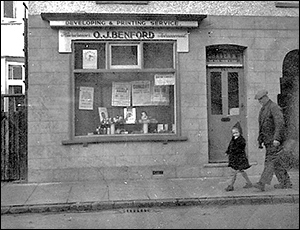 |
|
Jack Benford's shop at 20 Duke Street
|
20 Duke Street
(Shop 62)
The first record of this property being partly used as a shop was in the 1911 census when Henry Rymill was listed as having a picture framing business there. It was later opened as a chemists shop by Harold Harris. His actual address was 20A
Duke Street
as he lived not in the house but in
Winstanley Road
, Wellingborough and only rented the shop. He was first recorded there in 1923 and remained until 1931.
In 1932 the property, both shop and house, was purchased by Oliver John (Jack) Benford; he was a gents hairdresser but his business included photography and tobacco sales. He originally came to Burton Latimer in 1922 when he lived in
Finedon Street
and worked for Fred Evans at
45 High Street
. By 1926 he had his own business and worked from a room attached to the Finedon Street Working Mens Club, moving to
20 Duke Street
in 1932 from where he worked until his retirement. His eldest son Douglas (Dougie), also a gents hairdresser, had traded from his own shop at
120 High Street
since 1946 but moved to
20 Duke Street
in 1969. The shop closed in 1980 and became a private house. After the closure Dougie continued to work until his retirement by going to the homes of his customers to cut their hair, and would be seen around the town with his small brown case containing the tools of his trade. An Evening Telegraph article featuring Dougie can be found here.
Between number 22 and the Co-op stood the premises of A P Lewis, carpenters and builders. It was started by Alfred Pratt Lewis at the beginning of the 1920s later passing to his son Bert Lewis and then to his grandson Brian Lewis. At the front of the building was a small shop where wood could be bought cut to length as well as nails, screws and similar hardware. Sid Read looked after the shop and cut the wood from about the 1930s to the 1960s. The business transferred to
Kettering
in the 1990s and the building was demolished and replaced by residential housing.
The Duke Street Burton Latimer Co-operative Society buildings (Shop 63)
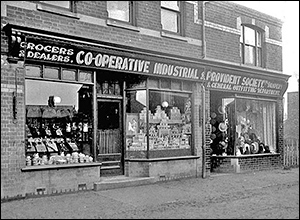 |
|
An early photograph of the Burton Latimer
Co-operative's Duke Street premises
|
These shops (shown as they are now in the panel at the top of the page) were built in 1891 and consisted of a grocery, drapery, a butchers shop and a bakery. The drapery was extended in 1924 to include furniture. During World War 2 (1939–1945) one of the shops on the street became the British Restaurant. From the late 1950s the co-op gradually ceased trading on this site, closing the shops one at a time. From about the middle of the 1960s the buildings were reused. The two on the right of the opening to the yard were used by builders A P Lewis Ltd (whose premises were attached to it on the right) and by the end of the 20th century they were converted into housing at the same time A P Lewis’s other premises were demolished and further residential homes built.
The original bakery was occupied from 1969 until the late 1970s by John Perkins and Partners who assembled brewery products. After that Bo Patrick traded as Park Patterns from about 1978 to 1980. The final business use was by Dexdirect who sold motorcycle parts and accessories; since Dexdirect ceased trading (about 2002) the building has remained unused (2007). The other buildings in the yard included the butchers shop and the abattoir and additional buildings were converted for use by C J Engineering, a general engineering company, and Target Craft who manufacture archery equipment, both with the same owners since the 1970s.
For a full history of Burton Latimer Co-op, click here
37 Duke Street
(Shop 64)
From about 1890 Charles and Ellen Capps lived with their children Agnes, Mary and George at number
35 Duke Street
. To the right side and rear was a fairly large plot of land. The larger portion owned by them and the rest owned by the Browns who lived in the house on the other side. By the 1890s the Capps family had a grocery shop in their front room and Charles was a Market Gardener and would have used the land for this purpose. In 1894 this shop was built and they moved there. It was a grocery and drapery and was later kept by the two sisters Agnes and Mary. Agnes was there until about 1950. It was always known in later years as “Ag Capps” shop. At some time possibly in the early 1920s there was a plan to continue
Spencer Street
through into
Duke Street
using this land. The Capps family was willing to sell but the Browns were not so it never happened.
In mid-1949 the business was bought by Mr & Mrs Fred Wittering who continued there until October 1954 when Mr Wittering was forced to retire through ill-health. The next owners, H and
E
Griffiths
, included toys in the range of goods for sale. The
Griffiths
were succeeded, from about 1975 until 1982, by George and Irene Marriott. There then was a change of trade after the premises were purchased by John and Marie Bull who opened a wool and pet shop. They continued this business until 1995 when the shop was permanently closed to become their private residence; it remains so in 2007.
The shop was demolished in 2008 and replaced by residential properties.
104/6 High Street
(Shop 64)
104 High Street
was built of stone on the corner of
Duke Street
and High Street. One window faced
Duke Street
and the other the High Street. The door was placed diagonally between the windows across the corner of the building. In this position it could have been in either street as numbers were not used at this time. This shop is thought to have been a butchers shop, possibly for a large part of the 19th century; the owners were possibly William Harding, James Ambler or Thomas Maycock. In 1902 the building was known to be a butchers shop trading as River Plate Meat Company. The owner is unknown but possibly it was run by Elias Smith who was listed as a butcher and journeyman. He had shops in
Finedon Street
,
Duke Street
(possibly including 3 Duke Street),
Rosebery Street
and in
Corby
at this time. He probably traveled around leaving someone else to run the shops. This shop could have been referred to as
1 Duke Street
if numbers had been used - number 106 was a wooden building and at this time was unlikely to have been a shop.
In 1906 both of the buildings were occupied by Albert Ward who lived at Little Harrowden and who manufactured and repaired cycles. From the early 1920s the business passed to his son, Alfred, who also carried out car repairs. Two petrol pumps were probably added at about this time. Alfred left the premises towards the end of the 1930s and from about 1938 the business was taken over by Charlie Charles, the nephew of Winifred Charles who owned the shop and post office almost opposite at
117 High Street
. Another resident of Little Harrowden, Charlie repaired cycles in the large wooden building. The shop on the corner contained stock and had displays in the windows but was never open. He was always very busy especially during the 1940s and 1950s and customers collecting their cycles usually had to search for them in the large heap of cycles. He had some fingers on one hand missing and could screw up nuts with his knuckles. The petrol pumps remained but had been unused since the 1930s. Charlie worked there until the 1970s and the buildings were demolished in 1978.
For more details about this section of the High Street, click here
116 High Street
(Shop 66)
This shop was built by the Burton Latimer Co-operative Society at the beginning of the 1950s. It was a grocery and butchery shop and the first branch manager was Reg Horn. It remained in this format until the early 1990s and is believed to have been the last co-op shop in the town to cease trading. The closure brought to an end to over 100years of trading by the co-op in the town. The shop together with its small yard was then occupied by W Drage Monumental Masons and for a short time a small café also operated from part of the premises. Following the transfer of the business to Earls Barton in 2005 the building was demolished (in 2006) and a residential block of flats have since been built on the site.
|
|
120 High Street
(Shop 67)
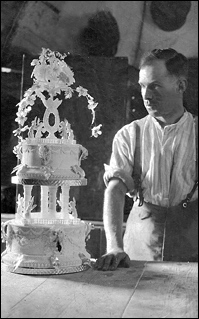 |
Frank Smith pictured in 1932
with an example of his work |
This shop was located on the corner of the High Street and
Piggotts Lane
. The first known owner, from1902 until 1945, was John Skevington who traded as a mens hairdresser and tobacconist. After World War 2 and after he left the armed forces, Douglas "Dougie" Benford occupied the shop; he also traded as a mens hairdresser and tobacconist from 1946 until 1969 when he moved to
20 Duke Street
, his father’s shop. In the early 1970s the building was demolished along with the others in the immediate area to make way for the new health centre.
Piggotts Lane
(Shop 68)
This was a bakery and, on entering the Lane, was next to the hairdressers (
120 High Street
). The first known owner, from 1910, was George Smith who was a baker and confectioner and from 1920 his son, Frank, joined him in the business. In later years they had a small van and Frank would go around selling bread and cakes, not only in the town but also Finedon and nearby villages. After George’s retirement in 1953, Frank continued until the closure of the business. The premises were demolished in the early 1970s along with the other buildings in the area.
Click here to read more about the Piggott's Lane area
|
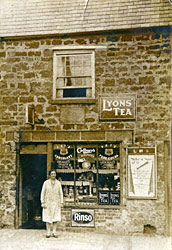 |
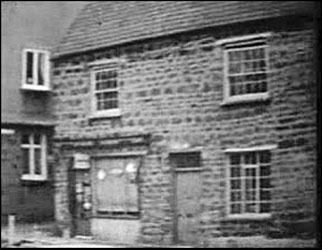 |
|
Emma Papworth - 1930s
|
Papworths 1950s
|
|
125 High Street (Shop 69)
The first recorded occupant of this property was Frank Gale who was listed on the 1911 census as a carrier and carter while his wife Ethel was described as a shopkeeper. After them the Hickman family carried on a similar business, Hannah Hickman running the grocery and general store from about 1913 until 1924. The premises were then taken over by Emma Papworth who ran the shop until her death in 1936. Ernest, her son, and Phyllis Papworth, who had married in 1937, were living there in 1939, now as owners. They were known to everyone as Ernie and Phyl and for a time they also had a small café. Until its demolition in 1964, the yard behind the shop was still used by Archie and Bill Hickman to keep their two lorries, often helped by Phyl and Ernie's son Billy.
|
|
|
|
129 High Street
(Shop 70)
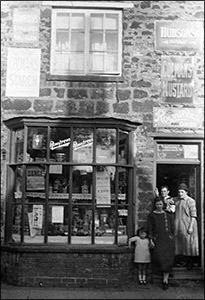 |
|
Ada Mason outside
her shop in about 1920
|
|
The first known owners of this shop from about 1900 were Mark and Ada Mason. From the trade directories of the time it was Ada Mason who appeared to run the shop; from the early years she advertised grindery, which would be sharpening knives and scissors and other similar tools. It was also a general store. A resident of the town remembers from the 1920s the contents of the shop to include sacks of monkey and tiger nuts, also paraffin, treacle and pieces of wood. Ada Mason was there until about 1938 when the premises were taken over by David and Edith Robinson. They were there until possibly some time during the Second World War but it is not known whether they ran a business from the address or only lived there.
From 1945 Harry and Bessie Firmin opened the shop as a drapery and lived there until the 1960s. The premises were demolished in 1964 along with number 127 and other buildings in the area. Harry and Bessie were the parents of Stan Firmin who was a well known motor trader in the town from the 1950s to the 1970s.
From the 1920s a room between this shop and number 127 was the first telephone exchange in the town. Vera Fox was the operator and she appears in the electoral register at 127 with the Hickmans, with whom she must have lived. The exchange could be accessed from 127 High Street by anyone wishing to make a call since few people had their own telephone at this time.
The house next to these shops was probably number 131. During the 1920s to the 1950s the front room was used part time by other traders. On Thursdays from the 1920s to the 1940s Fred Law, who lived in Irthlingborough, operated as a dentist. On another day coal accounts for Crosby and Beale could be paid. A small building between here and 149 was a boot and shoe repairers for most of the first half of the twentieth century, run by F W Tailby in the 1920s and H York by the 1950s by which time the number was listed as 147.
149 High Street , a stone built house which in 2007 remains standing between the Band Club and Sainsburys supermarket, was occupied by the Ambler family in the nineteenth century. 149 High Street was, in the second half of the 20th century, the home of Dennis Hornsby, a carpenter. Dennis developed a sideline making lace bobbins, which he sold at craft fairs, from bones supplied by his butcher, Les Sharman & Son. Robin Sharman relates how the only bones straight enough and thick enough to be worked were the rear leg and thigh bones from a bullock. Abraham Ambler, who was a grocer between the 1850s and the 1880s, may have owned either 127 or
129 High Street
. His brother Thomas who was a baker during a similar period may have occupied the bakery in
Piggotts Lane
. James Ambler and son Harry were bakers and butchers from about 1880 to the late 1890s and Amelia and Eliza Ambler also appear in directories as shopkeepers. During this period the history of 127 and
129 High Street
, the bakery in
Piggotts Lane
, and the butchery at
104 High Street
is unknown. These shops,
149 High Street
and Amblers Yard were all in a small area in what was then known as Main Street South End.
|
|
151 High Street
(Shop 71)
George Mason moved here in 1929 to the farmhouse known as Washpit Farm. He had moved his cycle and motor business from the shop at
50 High Street
. He worked from the existing farm buildings and a wooden building closer to the road. A considerable part of his business was in concrete products. He made garden ornaments such as bird baths and also slabs. From the wooden building he sold batteries, cycles and cycle parts and also offered a service charging batteries, including radio accumulators. In addition he manufactured cycles with a Masons name plate on them.
During the 1940s he built the main garage with the help of local builder Steve Lewis. He did most of the concrete work himself and made all the roof trusses. This gave him a large garage to carry out car repairs. There was also a showroom and several fuel pumps selling Regent petrol. Helping to run the business were his son Ken and his wife, his daughter Doreen and her husband Alan, and one other employee, Eddie York. In about 1962 George retired and he had a bungalow built at the rear of the site for himself. The garage was sold to the Burton Latimer Co-operative Society but George’s family and Eddie continued working there.
In about 1972 the co-op sold the garage and service station. The sale consisted of the garage buildings which occupied half the site on the right and the forecourt with the fuel pumps which occupied the front half to the left. The land and buildings behind the service station were owned by Frank Underwood, a local builder. David York, possibly with a partner, bought the garage buildings from the co-op and maybe also the forecourt. Alternatively Frank Underwood may have bought the forecourt, but this is unconfirmed. David continued to run the garage from the front half of the site, still trading as Regency Cars. The rear half was separated so there were two separate parts to the buildings. By the 1980s David York leased the premises to other traders rather than running the business himself.
A complete list of lessees is unknown at present but Rob Price was in the front part during the 1980s and it is currently trading as Jocks Car Sales (2007). The rear part of the garage was first occupied from 1972 to 1984 by Latimer Distribution, a parcel haulage business, owned by Len Bullard. Then in August 1984 it became a heavy goods vehicle repair business trading as Joyce Brothers, owned by Bill and John Joyce who also had several tipper lorries which carried sand and gravel. They closed their repair business in June 1997 when Bill retired; John continued to work with one truck for several years afterwards and parked it on the site. The buildings and yard were then occupied by Ken Perrin who returned it to a car repair business still trading (in 2007) as Citycall Services Ltd.
The petrol sales forecourt continued to sell Regent petrol, subsequently Texaco, although the ownership is uncertain. For a period during the 1970s and 80s Ted Hearne ran the petrol station and sold cars on the forecourt. Fuel sales continued until about the middle of the 1990s. It was then unused for a time then demolished and this part became a car park for the Budgen's (now Sainsbury's) supermarket. The shop itself is built on the rear part of the site on the left which had earlier been owned by Frank Underwood.
Click here for a further feature on the history of this site
|
|
160 High Street
(Shop 72)
These premises were owned by Alfred Kilborn, his wife Agnes and Alfred’s mother from the 1880s, and traded as a grocery, tobacconist and general store. They ran it until about 1928 when it passed to the daughter of Alfred and Agnes, Mabel Piper. Mabel looked after the shop whilst her husband Walter, an undertaker, ran his funeral business from the rear of the building. He made the coffins himself and was very proud of his carpentry. It has been said that at one point he almost put himself out of business because he did not approve of cremations destroying his work so quickly. Walter was a tall thin man and always wore his black suit and tie. He would appear in the rear of the shop silently as if he had appeared from nowhere and children considered him to be quite scary.
On the death of Mabel in the late 1970s the premises became a health and fitness studio, run by Barry Cleaver, and a ladies hairdressers. It has continued under several different owners in the same type of business. Since 1998 yhe property has been owned by Colette Bonner and currently (2007) the health and fitness centre is trading under the name of Bonners, run by John Smith, and the ladies hairdressers (trading as Bradys’) is run by a manager.
161 High Street (Shop 73)
These premises were built in 1923 for Fred Turner who traded in pots and crockery. He also had a dwelling built at the rear, numbered 167, where he lived with his wife Mabel and their three children. The rear is accessed by a drive to the right of 165 and also has a yard. Previously the family had lived in
Station Road
and Fred had traded (from about 1910) from a market stall at the cross in the centre of the town, visiting nearby villages on some days. The premises were sold to Miss Laura Chapman in July 1937 and she lived in the bungalow. During the time of her occupation it is not clear what (if any) business was carried out in the shop buildings. Miss Chapman died in November 1949. The premises were retained by her family until April 1953 when they were sold to Frederick Eady, a boot and shoe manufacturer. He used them as a leather store and, although unconfirmed, it is very likely he rented the business part before he bought it from Miss Chapman. In January 1956 he sold the property to Cecil Thompson who moved his motor business from Barton Seagrave. Cecil’s son Dennis worked with him; they repaired cars and sold used cars and scooters (they were Lambretta dealers). This enterprise lasted until June 1975 when it was sold to Brian Wells and David Helsdown who traded as Unit 2 Glass and manufactured windows. This business re-located to
Corby
in the late 1980s or early 1990s whereupon the premises were sold and became a childrens day nursery and, as Apple Tree Day Nursery, remains so in 2007.
17 Newman Street
(Shop 74)
The first known owner from about the early 1920s was Arthur Coles. His business was drapery and footwear, including boots, shoes, slippers and
Wellington
boots. In later years his son and daughter-in-law Geoff and Evelyn came into the business. A considerable part of their trade was on credit; Arthur and Evelyn ran the shop and Geoff would travel around collecting the money, often in the evenings. The business continued until the early 1970s when Geoff retired. The shop was closed and became their private residence and remains so in 2007.
182 High Street
(Shop 75)
This shop began as a butchers shop, the first known owner (in 1898) being Samuel James Northern. His address, on the corner of High Street and
Newman Street
, was recorded as Imperial Buildings, High Street. He was there until about 1912 when under the ownership of A Cave the premises became a grocery and provisions shop. At the beginning of 1922 Henry and Eveline Clarke purchased the shop and it continued as a grocery and confectionery shop. By about 1947 their son Ernest (“Ernie”) had taken over the shop and changed it to his own trade of radio and television sales and repairs. Around 1951 he moved to Finedon and continued his business in a shop in
Irthlingborough Road
.
In 1951 the High Street shop returned to being a grocery and confectionery shop when Florrie Blake moved from
1 High Street
. During the 1950s, when from the age of 12 onwards the town’s children went to school in
Kettering
, all the buses started their journey nearby. Florrie opened early and the shop would be full of children buying sweets; she retired in 1969. The shop was then taken over by Bob and Susan Law until 1972 and then, until about 1975, by a family named Lawless from Irthlingborough; all of these continued with the same type of general store. The shop then became the
Golden Gate
, the first Chinese take away in the town, and remains so in 2013.
9 Newman Street (Shop 75a)
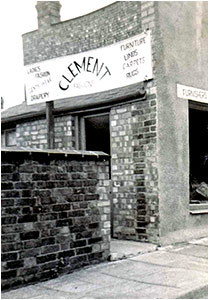 |
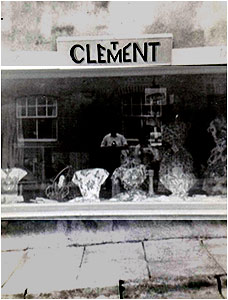 |
|
Trevor (Taff ) Clement's shop
at 9, Newman Street
|
Taff can be seen reflected in the
shop window glass taking a this
photograph
|
To the rear of 182 High Street is 9 Newman Street, a small building which has had various uses. It is thought to have been built as a slaughterhouse/store for the butcher's shop nearby at 182 High Street, when it was owned by Samuel Northern. The meat hooks were still hanging from the ceiling when Mr Trevor (Taff) Clement moved there in 1958. He first opened it as a dress shop and it then developed into an upholstery business until he moved to Kettering in 1977. David Smith then had it to manufacture shoe components and leather goods. He sold it in 1988 to Lawrence Stapleton who operated a property conveyancing business between 1988 and 1990 when he moved to 36 High Street . The next (unknown) owner was a furniture upholsterer until about 1993 and it then became a chiropractic surgery which it remains in 2013.
|
|
|
|
